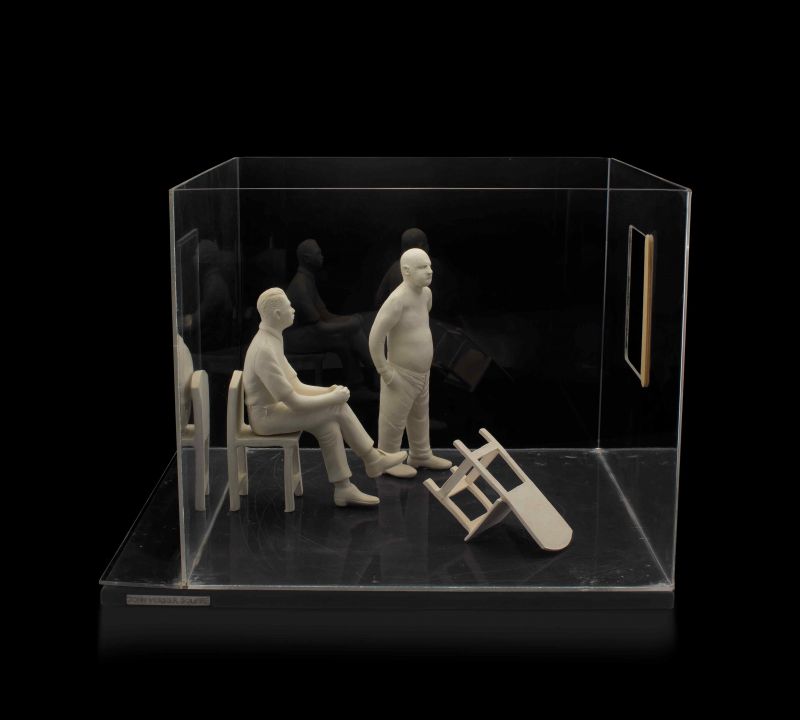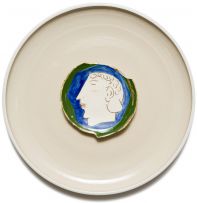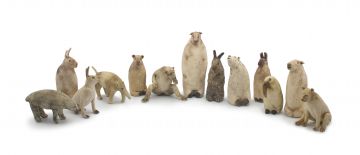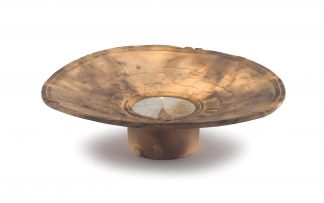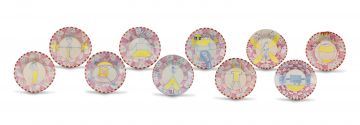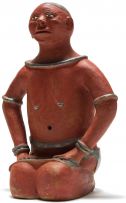Modern, Post-War and Contemporary Art, Decorative Arts, Jewellery and Fine Wine
Live Virtual Auction, 8 - 11 November 2020
South African Ceramics, Selected Prints and Multiples
Incl. Buyer's Premium & VAT
About this Item
Notes
The title of this disquieting installation by Anne Marais takes its cue from Nelson Mandela's 1994 inauguration speech, when the first president of the new South Africa proclaimed that 'Never, never and never again shall it be that this beautiful land will experience the oppression of one by another.'1 Produced a decade after that declaration, Marais' sculpture is a chilling testament to the ghosts of oppression that Mandela saw haunting the fragile foundations of South Africa's nascent democracy.
Marais makes visible such a spectre through what the work leaves absent; two porcelain figures, one seated, the other standing, gaze coldly at an open window, whilst an upturned chair suggests some kind of previous commotion. The Perspex box that sets this scene features a door with the label Room 1026, and is completed by a black base with the inscription 'John Vorster Square'.
Marais conjures a history of unresolved justice that, at the time of the sculpture's making in 2004 was still ongoing. The room number refers to the infamous venue located on the 10th floor of John Vorster Square (today Johannesburg Central Police Station) where apartheid police would interrogate and torture political detainees, in some cases dropping them from the window to their deaths.2
Perhaps the most infamous of these murders was the case of Ahmed Timol who died in December of 1971 after an interrogation in Room 1026, where officials claimed that he had jumped rather than being thrown. The inquest that immediately followed found in favour of the police, and the case was put down to suicide. It would take 46 years for the inquest to be reopened with Judge Billy Mothle declaring in 2017 that Timol's life had resulted in wrongful death, thereby setting the precedent for reopening of other such apartheid era inquests.3
Marais' restaging of the moments directly after such a gruesome event is part of an ongoing frame of post-apartheid redress where the past is brought into focus in order to remind us, in the present, that many of our country's ghosts, whilst invisible, still remain.
1. Sello Hatang (2020) 'Never, never and never again', Nelson Mandela Foundation, https://www.nelsonmandela.org/news/entry/never-never-andnever-again
2. South African History Archive (n.d.) 'Detention without trialin John Vorster Square', https://artsandculture.google.com/exhibit/detention-withouttrial-in-john-vorster-square-southafrican-history-archive/gQ-1o9MM?hl=en
3. Jason Burke (2017) 'South Africa judge rules police murderedanti-apartheid activist in 1971', The Guardian, https://www.theguardian.com/world/2017/oct/12/south-africajudge-rulespolice-murdered-anti-apartheid-activist-in-1971
Provenance
Purchased from the Brett Kebble Art Awards Exhibition, 2004.
Private Collection.
Exhibited
Brett Kebble Art Awards, Cape Town, 2004.
Literature
Clive van den Berg (ed)(2004) The Brett Kebble Awards, Cape Town: Brett Kebble, illustrated in colour on page 150.
